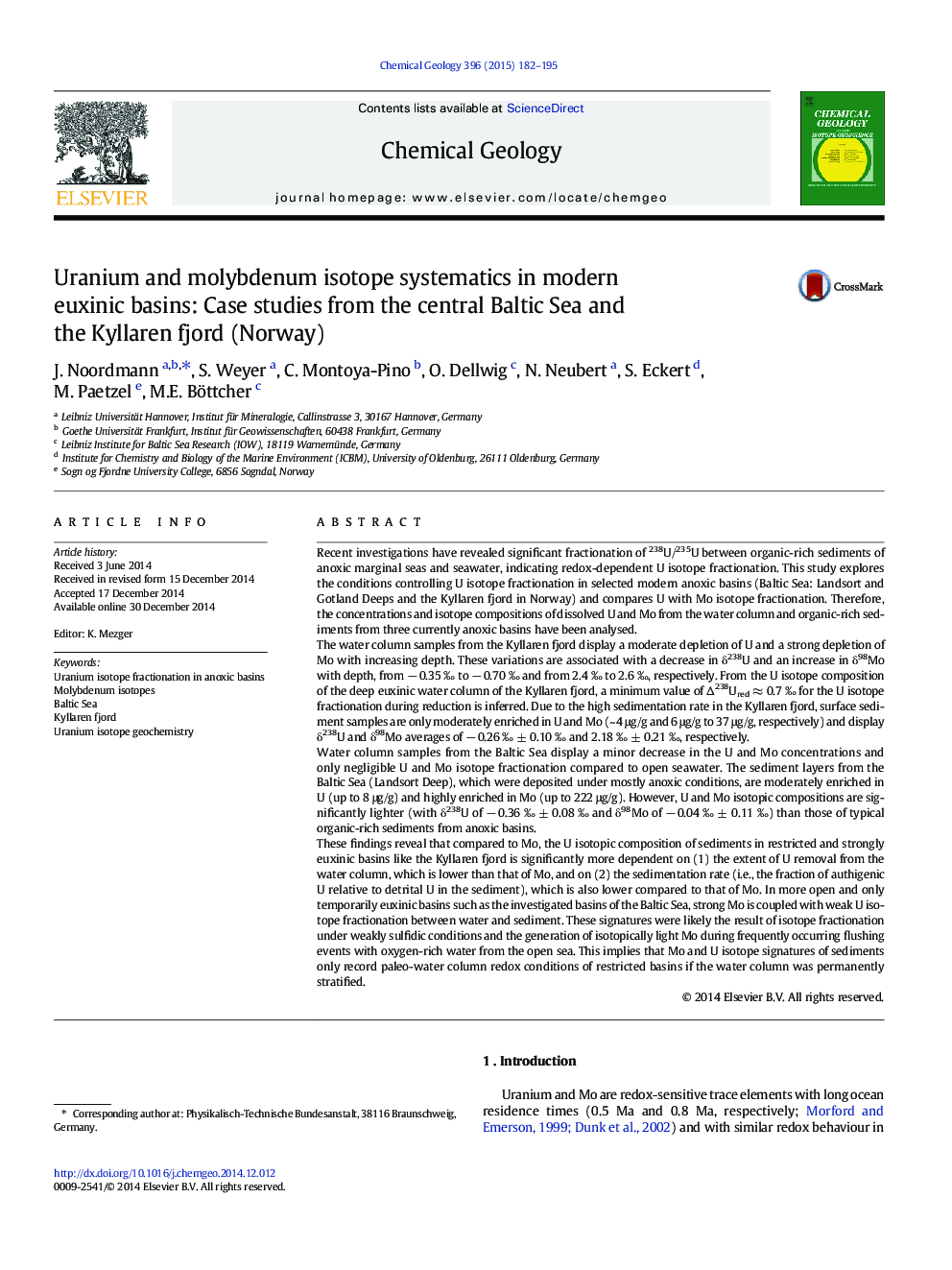| کد مقاله | کد نشریه | سال انتشار | مقاله انگلیسی | نسخه تمام متن |
|---|---|---|---|---|
| 6436516 | 1637577 | 2015 | 14 صفحه PDF | دانلود رایگان |
- Dissolved uranium of restricted anoxic basins is isotopically lighter than open ocean U.
- Uranium of restricted anoxic basins is isotopically lighter than their respected sedimentary Uâ².
- Uranium isotope fractionation in restricted anoxic basins depends on the extent of U removal from the water column.
- The sedimentation rate in those restricted anoxic basins strongly affects the U isotope composition of the sediments.
Recent investigations have revealed significant fractionation of 238U/235U between organic-rich sediments of anoxic marginal seas and seawater, indicating redox-dependent U isotope fractionation. This study explores the conditions controlling U isotope fractionation in selected modern anoxic basins (Baltic Sea: Landsort and Gotland Deeps and the Kyllaren fjord in Norway) and compares U with Mo isotope fractionation. Therefore, the concentrations and isotope compositions of dissolved U and Mo from the water column and organic-rich sediments from three currently anoxic basins have been analysed.The water column samples from the Kyllaren fjord display a moderate depletion of U and a strong depletion of Mo with increasing depth. These variations are associated with a decrease in δ238U and an increase in δ98Mo with depth, from â 0.35 â° to â 0.70 â° and from 2.4 â° to 2.6 â°, respectively. From the U isotope composition of the deep euxinic water column of the Kyllaren fjord, a minimum value of Î238Ured â 0.7 â° for the U isotope fractionation during reduction is inferred. Due to the high sedimentation rate in the Kyllaren fjord, surface sediment samples are only moderately enriched in U and Mo (~ 4 μg/g and 6 μg/g to 37 μg/g, respectively) and display δ238U and δ98Mo averages of â 0.26 â°Â ± 0.10 â° and 2.18 â°Â ± 0.21 â°, respectively.Water column samples from the Baltic Sea display a minor decrease in the U and Mo concentrations and only negligible U and Mo isotope fractionation compared to open seawater. The sediment layers from the Baltic Sea (Landsort Deep), which were deposited under mostly anoxic conditions, are moderately enriched in U (up to 8 μg/g) and highly enriched in Mo (up to 222 μg/g). However, U and Mo isotopic compositions are significantly lighter (with δ238U of â 0.36 â°Â ± 0.08 â° and δ98Mo of â 0.04 â°Â ± 0.11 â°) than those of typical organic-rich sediments from anoxic basins.These findings reveal that compared to Mo, the U isotopic composition of sediments in restricted and strongly euxinic basins like the Kyllaren fjord is significantly more dependent on (1) the extent of U removal from the water column, which is lower than that of Mo, and on (2) the sedimentation rate (i.e., the fraction of authigenic U relative to detrital U in the sediment), which is also lower compared to that of Mo. In more open and only temporarily euxinic basins such as the investigated basins of the Baltic Sea, strong Mo is coupled with weak U isotope fractionation between water and sediment. These signatures were likely the result of isotope fractionation under weakly sulfidic conditions and the generation of isotopically light Mo during frequently occurring flushing events with oxygen-rich water from the open sea. This implies that Mo and U isotope signatures of sediments only record paleo-water column redox conditions of restricted basins if the water column was permanently stratified.
Journal: Chemical Geology - Volume 396, 9 March 2015, Pages 182-195
